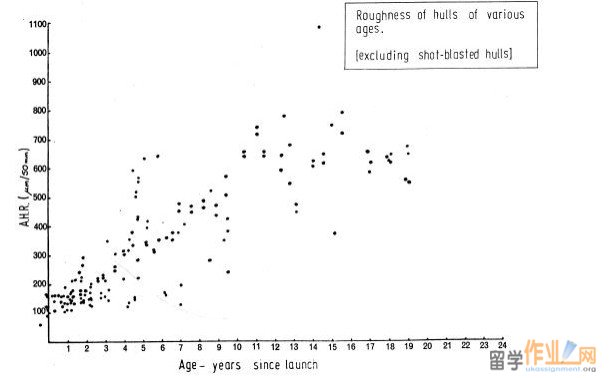|
Hull and propeller: existing ships
船体和螺旋桨:现有船舶
Hull
船体
The impact of hull maintenance on the GHG emissions is through the effect of hull roughness on ship resistance. Ship viscous (friction) resistance increases markedly with increasing hull roughness. Hull roughness tends to increase during the service life of a ship (see Figure 5-2) and might increase significantly between dockings, depending on the paint system applied. The increase in roughness depends not only strongly on how the ship is maintained, but also on operational area and operational profile. It is very difficult to obtain statistics on the current status regarding hull roughness and maintenance practises. What is considered typical roughness increase will be discussed, as well as what is obtainable by best practice. Then, the difference in terms of power consumption for the four case ships defined in this study will be computed.
船体维护温室气体排放量的影响是通过船舶阻力的影响,随着船体粗糙度,船舶粘性(摩擦)阻力明显增加。船体粗糙度趋于增加,船舶的使用寿命期间(参见图5-2)之间的对接,可能会显着增加,这取决于系统上的油漆。
Wen discussing hull roughness, the issue of antifouling paint systems is unavoidable. Modern self-polishing antifouling paint systems have significantly reduced the problem of increasing roughness between dockings, as long as maintenance intervals of the paint system are not exceeded. In fact, decreasing roughness in service has been reported, according to [Townsin, 1980]. However, how the hull maintenance is performed when in dock has been found to be very important. This is illustrated by Figure 5-2, where older ships obviously have been docked numerous times, and by Figure 5-3, which directly reports that for hulls that are initially fairly smooth, the roughness is typically increasing as a result of the docking. From this, one might conclude that in addition to use a self-polishing (or similarly effective) paint system, improved practice during hull maintenance must be introduced. In addition, re-blasting the hull should be performed with regular intervals.
由此看来,人们可能会得出结论,除了使用自我抛光(或同样有效)涂料体系,在提高实践船体维修过程中必须引入。此外,应进行定期重新爆破船体。

Figure 5-2 - Roughness of Hulls of Various Ages, Excluding Re-Blasted Hulls [Townsin, 1980]
图5-2 - 粗糙度不同年龄的船体,剔除重新喷砂的船体[Townsin,1980]
Figure 5-3 - Change in Average Hull Roughness (AHR http://www.ukassignment.org/uklunwen/ ) Between Indocking and utdocking [Townsin,1980]
Based on this, it our opinion is that hull roughness can be kept at approximately the level of a new ship, which is assumed to be 150 mm, by application of best practice hull maintenance. The combination of typical drydocking workmanship, but use of self-polishing paint which is judged to be current common practice, the increase in roughness following dockings is assumed to be 30 mm. For a ten-year old ship, typically docked twice, this gives an additional roughness of 60 mm. Such a roughness increase implies an increase in power demand to maintain speed of 3-4%.
对于一个10岁的船,通常停靠两次,这给出了一个额外的粗糙度为60毫米。这样的粗糙度增加意味着电力需求保持3-4%的速度增加。
For the service life of a vessel, an increased hull roughness implies increased viscous resistance. As a consequence, there will be an increased power demand to maintain speed. Use of substandard paint systems, long periods in harbour, long stays in warm waters, and/or exceeding of the service life of the paint systems will increase roughness greater than 60 mm. A significant part of the world fleet will probably be in this category. Thus, it is proper to set the saving potential by perfect hull maintenance to more than the 3-4% given by the 60 mm roughness increase, and 5% is considered as a the more likely figure.
一艘船的使用寿命,增加船体粗糙度意味着增加粘滞阻力。结果是,将有一个增加的电力需求,以保持速度。不合格的涂料系统,长时间在海港,长期停留在温暖的水域,和/或超过使用寿命的油漆系统的使用将增加粗糙度大于60毫米。
Propeller
螺旋桨
Retrofit of propeller alternatives described in Table 5-1 on existing ships has been performed and may result in reduced fuel consumption. Although some references exist on results from retrofit on existing ships, it is difficult to establish general conclusions as in the case for new ships, and due to this retrofit has not been further investigated in this section.
已经执行了表5-1中所述的替代品,在现有的一般的螺旋桨改造,并可能会导致降低了燃料消耗。虽然存在一定的参考改造现有船舶的结果,它是在新船,还没有得到进一步的调查,在本节中,由于这种改造的情况下,很难建立一般性的结论。
Propeller roughness has been much less in focus than hull roughness, probably because the possible impact on fuel consumption is less. Grigson (1982) presents a method for calculation of increase of propeller blade drag due to roughness. Based on his method, it is possible to do a fairly good estimate of the increase in power, if the increase in roughness is known. There are however very few measurement data of increase of roughness in service. Thus, it is tempting to use Grigsons highly empirical estimate of 3% increase in power consumption due to a typically roughened propeller. To keep the propeller roughness increase at a low level the propeller roughness should be properly measured when the ship is docked, and the propeller polished if the roughness has increased above 0.2 mm. It is important to stress that an actual measurement needs to be carried out both before and after polishing. Visual observation is not sufficient. This is considered a cost-effective means of reducing power.
须重要强调的是,在实际测量抛光之前和之后都需要进行。目测观察是不够的。这被认为是一个降低功耗具有成本效益的手段。
The measures considered most promising are given in Table 5-3 below. These measures could have been presented later in this chapter under operational measures, but are presented in this section as they were defined as technical rather than operational measures.
被认为最有希望的措施,在下面的表5-3中给出。这些措施可能已提出,将在本章后面运作措施下,但本节介绍它们被定义为技术性而非运营措施。
Table 5-3 – Energy reduction potential for existing ships – hull/propeller measures
表5-3 - 现有船舶的节能减排潜力 - 船体/螺旋桨措施
|

